A papad is a very common food in India, which is essentially served as an accompaniment with main course combinations like dal-rice, sambar-rice, etc. It can be either fried or roasted, till crisp and essentially needs to be consumed immediately in order to enjoy the crispiness. However, there are recipes like this Masala Papad, which turns the papad into a scrumptious Snack or starter in itself. This is basically fried papad topped with a spiced and tangy onion-tomato mixture. It is super duper easy and quick too.
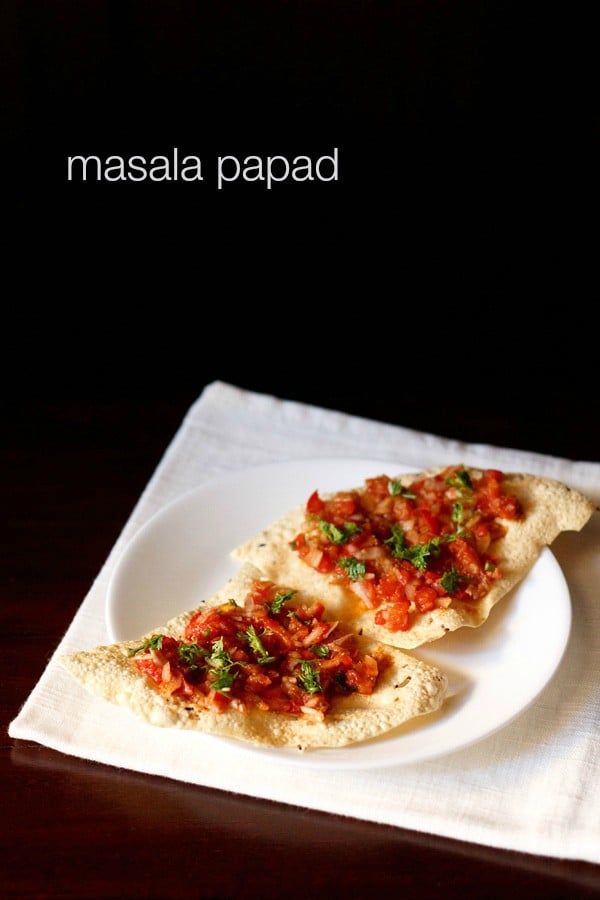
Table of Contents
What is Papad
Papad is a popular side dish, not just in Indian cuisine but also the cuisines of Bangladesh, Nepal, Pakistan, Sri Lanka and the Caribbean. Typically, it is a dough made of urad dal (black gram) flour, which may or may not be spiced, and rolled into thin discs.
These discs can further be roasted or fried and served with main course dishes, topped with spiced mixtures, chutneys, etc. like this Masala Papad or even added to curries. A papad ki sabzi is one such well-known papad gravy in the food culture of Rajasthan in North India.
Just like other recipes with regional variations in India, a papad also has many varieties throughout the length and breadth of our country.
So, it can also be made with other flours of other dals/lentils, rice, millets, chickpeas, potato, sago, jackfruit etc. There are even non-vegetarian versions like the ones that have shrimps/prawns, which are similar to the Southeast Asian prawn crackers.
For the same reason, papad also is referred to by many other local names that vary from region to region in India. Besides ‘papad’ in Hindi, Punjabi, Gujarati and Marathi, some other regional names include ‘pappadam’ (Malayalam), ‘appalam’ (Tamil), ‘pampada’ (Odia), ‘appadam’ (Telugu) and ‘happala’ (Kannada).
One of the iconic Indian brands that is associated with the mass-scale manufacturing of papad is the Lijjat Papad Company based out of Mumbai, Maharashtra in western India. One of the most striking facts about this brand is the fact that it is completely a women-led organization, till today.
About Masala Papad
Masala Papad happens to be one of our most favorite starters that we have to order, whenever we are dining at an Indian restaurant. Till the main course arrives on the table, we happily enjoy nibbling onto crisp papad topped with a spicy mixture. So, it was quite obvious that I had to have a recipe of it too.
This is not a recipe as such, but just a method on how to assemble a Masala Papad in the most basic, yet delish way. You can very well have your own spice and herb variations. Plus, increase or decrease the proportions of the masala topping ingredients like onions, tomatoes or the spices.
Traditionally to make Masala Papad, urad dal papads are used. Preferably the ones spiced with black pepper or kali mirch. Going by the same, I use the kali mirch urad dal papads by Lijjat to make Masala Papad at home.
You can either fry or roast the papads. The roasting can be done on open fire, a grill or even microwave oven. However, we at home, prefer the fried ones over the roasted ones.
Along with the Masala Papad, you can also try these recipes of Onion Salad and Masala Raita that are also common accompaniments in Indian cuisine.
Make sure to serve Masala Papad immediately as soon as you assemble them. They go very well as a starter snack with any Indian main course menu.
How to make Masala Papad
Make Masala Topping
1. Take all the ingredients for the masala topping in a bowl:
- 1 medium finely chopped onion
- 1 medium finely chopped tomato
- ½ teaspoon red chili powder
- 1 teaspoon roasted cumin powder
- 1 teaspoon chaat masala powder
- salt as required
Add less salt as chaat masala already has black salt in it.
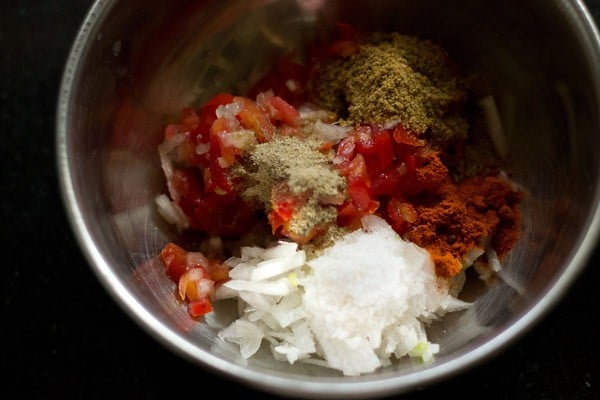
2. Add 1 teaspoon lemon juice.
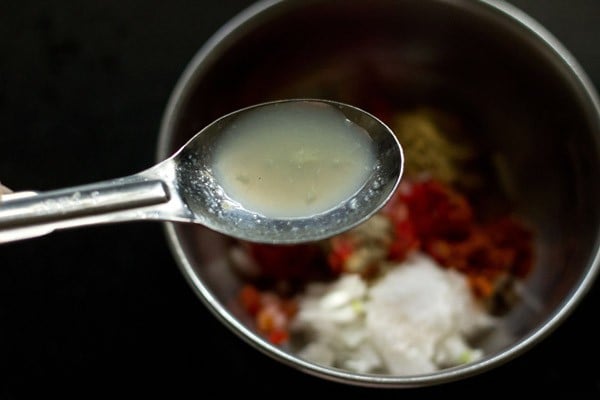
3. Mix well. Check the taste and add more salt, any of the ground spice powders or lemon juice, if required. Make this masala topping just before you fry the papad.
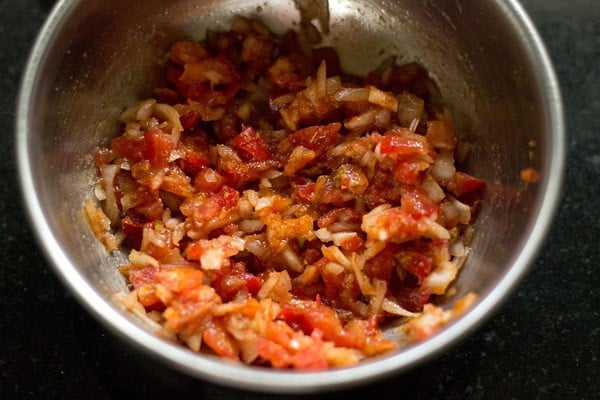
Fry Papad
4. Take 2 to 3 papads. You can take large or medium papad.
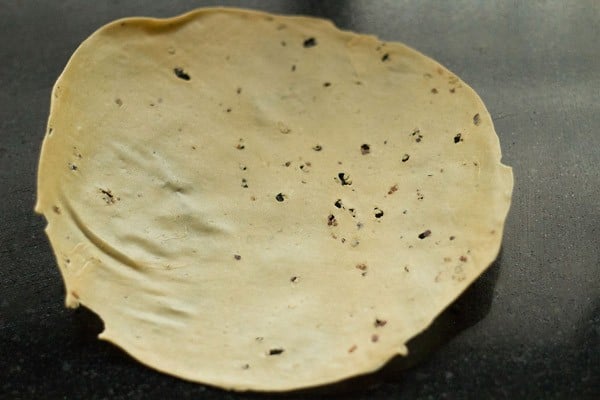
5. Since this papad was large, I broke it into 4 pieces. You can keep the papad intact, if you prefer.
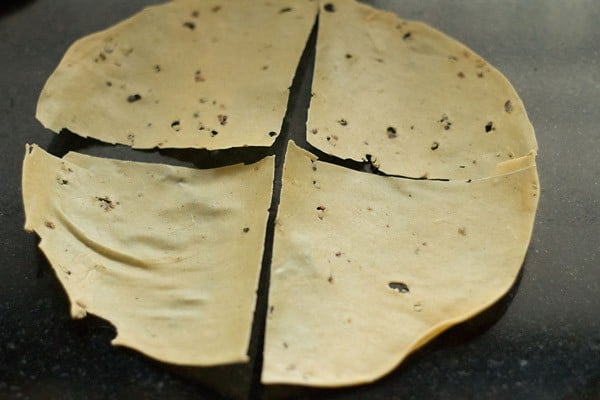
6. Heat oil for shallow frying in a pan and slide the papad pieces into the hot oil. Make sure the oil is hot enough or else the papad will absorb too much oil.
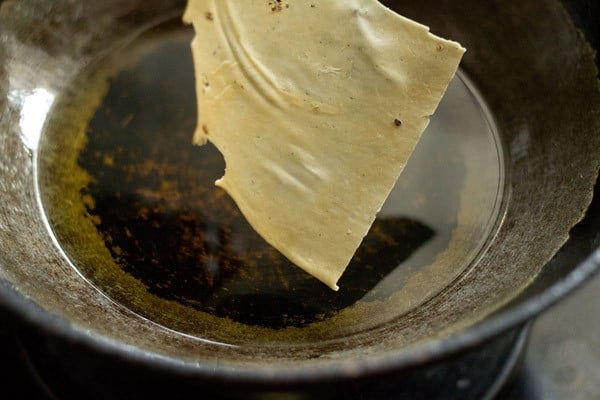
7. Fry on medium to medium-high heat for some seconds or till the papad is crisp. No need to brown it.
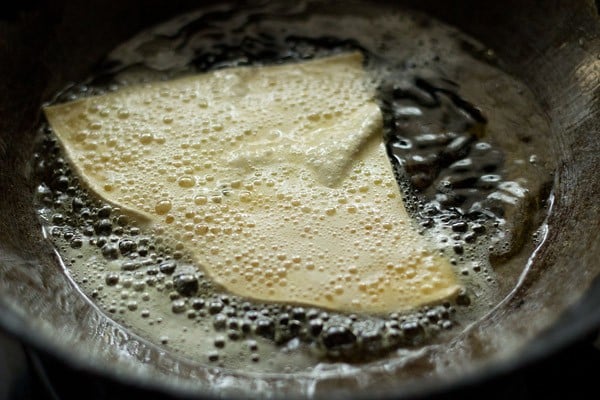
8. With a slotted spoon or tongs, remove the papad and drain the oil.
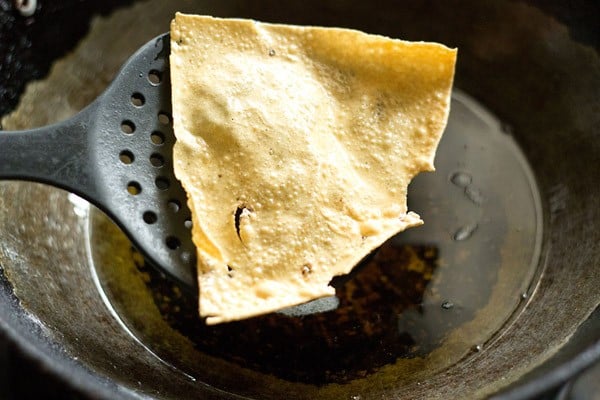
9. Place the fried papad pieces on a kitchen paper towel so that excess oil is absorbed. You can also turn the fried papad pieces once oil is absorbed from one side.
If you plan to serve the Masala Papad later, store the fried papad pieces in an airtight container. They will remain crisp.
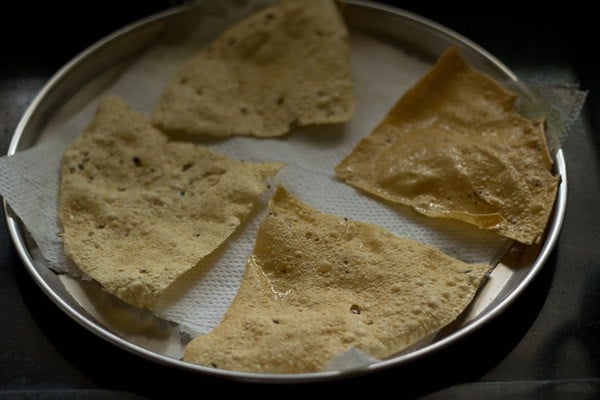
Make Masala Papad
10. Spoon the masala topping on the fried papad pieces.
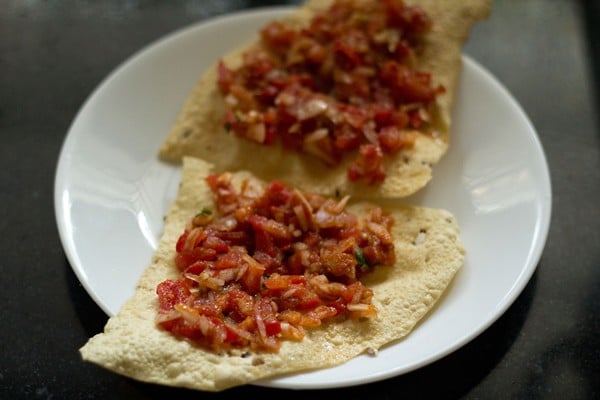
11. Sprinkle chopped coriander leaves.
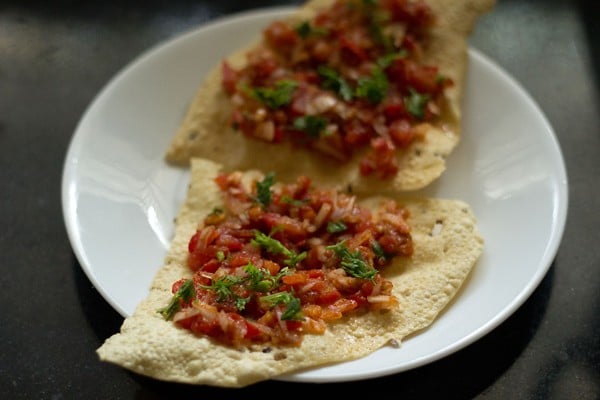
12. Serve Masala Papad immediately or else they turn soggy.
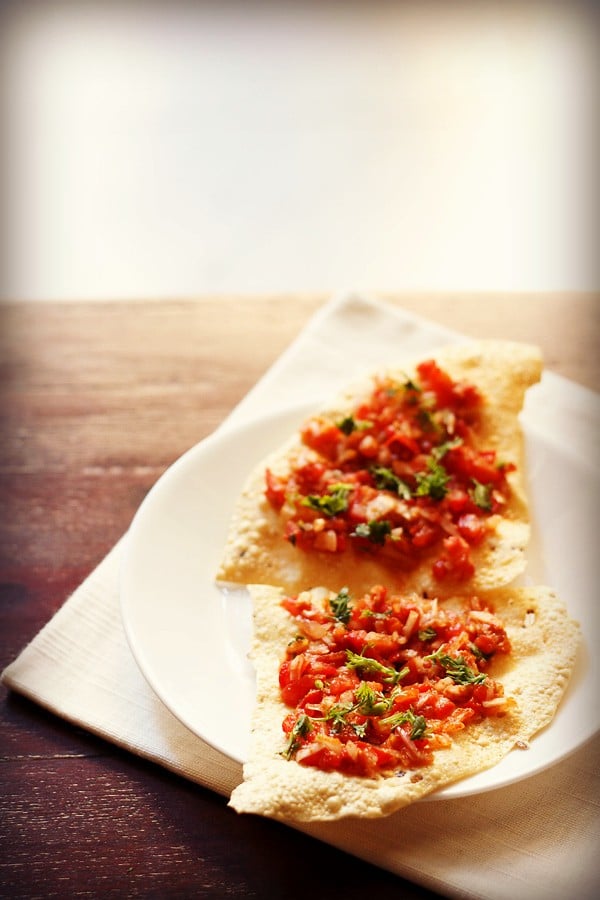
Expert Tips
- Since chaat masala already has black salt in it, ensure adding less salt in the masala topping.
- Seasonings, spice powders and lemon/lime juice can be adjusted, as per your personal preferences. Make sure to be ready with the masala topping before you fry the papads.
- You can use large or medium size papads for this recipe. If using large ones, you can also break them further into smaller, bite-size pieces.
- The papads have to fried till crisp, and not browned. In case you want to serve Masala Papad later, store the fried papads in an airtight container that helps to keep the crispiness intact.
- Best way to relish these masala laden papads is to have them immediately after assembling. Or else they turn soggy.
More Easy Snacks Recipes To Try!
Snacks Recipes
Snacks Recipes
Breakfast Recipes
Please be sure to rate the recipe in the recipe card or leave a comment below if you have made it. For more vegetarian inspirations, Sign Up for my emails or follow me on Instagram, Youtube, Facebook, Pinterest or Twitter.
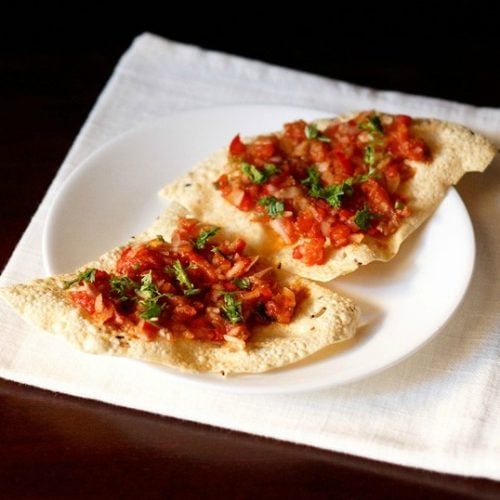
Masala Papad Recipe
Ingredients
- 2 to 3 urad dal papad (large-sized) or 4 to 6 medium-sized urad dal papads
- ½ cup finely chopped onions or 1 medium-sized
- ½ cup finely chopped tomatoes or 1 medium-sized
- 2 tablespoons chopped coriander leaves (cilantro)
- 1 teaspoon lime juice or lemon juice or add as requried
- ½ teaspoon red chilli powder or 1 or 2 green chilies, finely chopped
- 1 teaspoon roasted cumin powder – optional
- 1 teaspoon chaat masala or add as required
- salt as required
- oil as needed for shallow frying papad
Instructions
- Take all the ingredients for the masala toppings in a bowl – finely chopped onions, tomatoes, red chili powder, roasted cumin powder, chaat masala powder and salt.
- Add lime juice or lemon juice and mix well. Check the taste and add more salt or any of the ground spices or lime juice if required. Make this masala filling just before you fry the papad.
- Take the papad. You can take large papad or medium-sized papad.
- Heat oil for shallow frying in a pan and slid the papad into the hot oil.
- Fry on medium to medium-high heat for some seconds till the papad is crispy. No need to brown them.
- With a slotted spoon or with a tong remove the papad and drain the oil. Fry the remaining papad in batches.
- Place the fried papad on a paper kitchen towel so that excess oil is absorbed. You can also turn the fried papad once oil is absorbed from one side. If you plan to serve the masala papad later, then store the fried papad in an airtight container. They will remain crisp.
- Spoon the masala filling on the fried papad.
- Sprinkle some chopped coriander leaves.
- Serve Masala Papad immediately or else they turn soggy.
Notes
- For a light, low fat snacking option, roast the papad instead of frying them.
- Adjust the seasonings and spices in the masala filling according to your taste preferences.
- Scale the recipe easily if making masala papad for pot lucks or small parties.
- Make ahead by frying the papad a few hours earlier and storing them in an air-tight container. Before serving, make the masala stuffing and top the papads with it.
Nutrition Info (Approximate Values)
This Masala Papad recipe post from the archives first published in November 2014 has been republished and updated on November 2022.
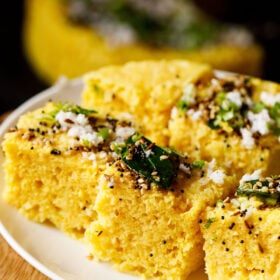
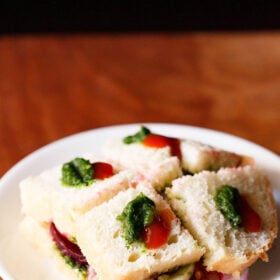
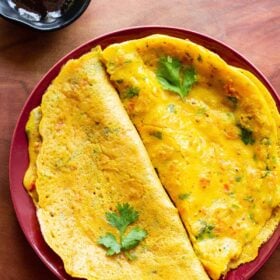
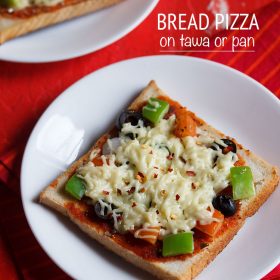
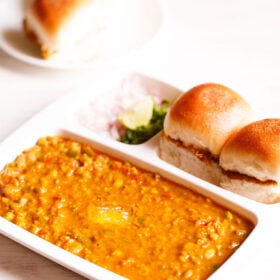
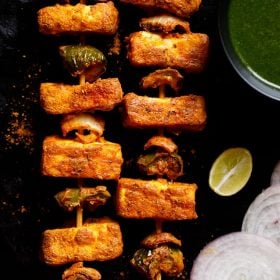
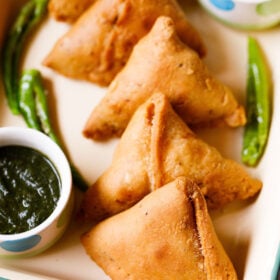









Hello. Mine were bit bitter . What could be the reason. May be cz I added black salt way too much?
deeksha, black salt won’t make it bitter. bitterness can come from onions. when you chop onions, do make sure that you remove the root part of it. it its there, it can create bitterness in any dish. also depending on the quality of onions, it can be bitter.
Very good method of explanation.Your website has such a wide variety of recipes.Very helpful for freshers to cooking like me.Just love your site.
thanks venkatesh for sharing positive feedback. glad to know this.
just lllllllooooooooovvvvvvveeeeeeeedddddddddd this…. thnk u sooo much
dassana this one….
yummmmm
welcome sejal
This is great blog of recipes, i generally visit this blog to cook new recipes.
thanks hrishkesh
Hello mam,
can u post the recipe of TOMATO-SEV BHAJI.
suvidha, i have noted down the recipe request and will try to post it soon.
Thanks a lot….
welcome suvidha
Its my all time favorite 🙂 I try making it as a salad with roasted papad